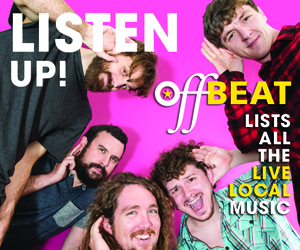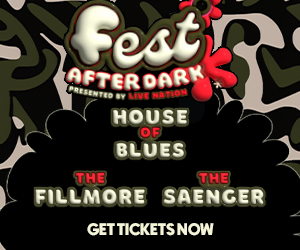This Saturday, April 6, an award-winning Cuban funk musician will make his United States debut when he joins The Soul Rebels on stage at Tipitina’s.
Cimafunk was named 2018 “Artist of the Year” by Vistar magazine and a Billboard top 10 Latin Artist to watch in 2019. Combining the historic traditions of Cuban music together with funk, R&B and Afro-Cuban rhythms, Cimafunk self-defines as a “free being defying classification.” Since releasing his debut album, Terapia, in 2017, his popularity has made him one of the island nation’s pre-eminent rising stars (he recently headlined the Havana Jazz Festival). Now, he’ll continue to expand his success as he performs alongside some of New Orleans’ most prolific musicians.
Opening for Cimafunk on April 6 are Jon Cleary and special guest Herlin Riley. Riley will sit in during Cleary’s set, so there will be two epic drummers on stage, providing fans with rhythms inspired by the Caribbean. Then, Best of the Beat Award-winning band The Soul Rebels will sit in with Cimafunk.
There are so many connections between the musical cultures of Cuba and New Orleans,” says Erik “Cimafunk” Rodriguez. “A night like this has been a dream of mine for a long time. We can’t wait to calentar (heat up) New Orleans!”
Cimafunk’s appearance in town is about more than performing, though. The show at Tip’s is part of a larger U.S. tour that kicked off at the South by Southwest Music Festival in Austin, Texas. During the tour, Cimafunk will visit local schools and neighborhood programs in partnership with Cuba Educational Travel’s U.S. Cultural Exchange Program. While in New Orleans, a workshop is planned with students from the Trombone Shorty Foundation, as well as a variety of local artists and tradition bearers.
Cimafunk spoke with OffBeat.com about his auspicious upcoming gig, the connection between Cuba and New Orleans, and more.
There’s been a big focus on the relationship between Cuban and New Orleanian musicians lately – including the award-winning film “A Tuba to Cuba.” How and when were you first exposed to New Orleans music, in Cuba?
This is one of the first times I’m really in touch with the New Orleans musicians. Before this, I never shared the stage, I never produced something with another musician from New Orleans, it’s always just been musicians from the U.S. I know that within the different regions there are many special sounds, but I’d never gotten the chance to be in relationship with any of them. We have access to the internet right now, which we didn’t have before. So for me, what I knew about the musicians from New Orleans were the horns. I think that a lot of people knew about that. Everybody goes crazy over them. That was the first time I really knew what was happening in New Orleans, after that, I started listening to Trombone Shorty, I started to follow his music. I didn’t know many of the musicians I listened to, if they were from New Orleans or they were from wherever, and some I still don’t know. But yes of course, we’re being connected.
For those Americans who’ve never been, what can you say about the music scene in Cuba? What are some of the various kinds of native music there, and how do you connect them to the African heritage that New Orleans jazz has?
For the musicians and people that haven’t been to Cuba, in my experience musically, the main connection is the style we bring from Africa—it’s the groove, the rhythm, and the sexual, tribal state that those rhythms create. It’s like we’re very similar. After I started seeing videos from New Orleans musicians in the street, it’s very similar to what we do in the Carnavals in La Habana and Pinar del Rio, with people running in the street with horns, with drums, with many percussion instruments and singing in the streets without a microphone. It’s very similar, much more similar than other places, and I see what happens there with the Cimarron, all of this is very similar. And I know that for the musicians that have never been to Cuba, I know they will feel very close to home. Especially if they arrive at the right moment, with Carnaval in the streets, the parties in the streets, they’re going to feel at home.
Tell us about the music you make – for someone who’s never heard you perform live, how would you describe your sound? What can people expect to see from your live performance in New Orleans?
I think that I’m still looking for a real song that I can define, more specifically. Right now it’s experimental. I’m experimenting, just mixing things and having fun. I’m trying to arrive to some place where I can say “Okay, this is a Cimafunk song.” It’ll be something you can hear, my music in some place, and even if you’ve never heard the song, you know it’s my song. That what I’m trying to do, but I know I haven’t arrived there yet. What my music has, it’s like, we try to improve the groove, try to communicate with the funk groove and the afro groove. That’s the main thing, they’re very close one to the other, and when you put them together, crazy things start to come out of it. And when you pass ten minutes in one groove, and the people are dancing and you’re dancing and every instrument is making these little connections, everybody is in communication with everybody—it’s a tribal sensation. It’s what I do know that my songs have. But one specific description, I don’t have that. I know that I’m making funk with Afro-Cuban music, but I cannot describe 100% the essence. It’s really complicated, especially now that I’ve only just begun to do this kind of music.
For my performance in New Orleans, I think we’re gonna enjoy it, that’s what I always do, me and my team, we’re always enjoying the performance, the happiness and the passion. Everybody loves that. I just hope that the people get to be in communication with us and feel the message and join us in that—join us in the groove, in communication with the groove. That’s what I expect. And we always enjoy the shows—it’s the best moment of the week, of the day, that moment when we arrive to the stage ready to give everything. So that’s what we’re gonna do. I expect that they feel freedom, that they feel free to feel my music in their own way.
As a Cuban musician, is there any special significance to you about making your American debut?
Yeah definitely, it’s super special. Super special. This is a country of so much music, this is a country blessed by music. We have been feeding from his music, and this country has been feeding from Cuban music for many, many years. So we have history together in that music, that we have revolutionized with different sounds. So for me, it’s been a dream to arrive here and get to know so much groove and musical tradition, and to be able to express myself on stage. And now every time we play for people here, I start to see the reactions, and every concert changes my perception of my own shows. And that’s super important for me.
The U.S. and Cuba are too close. We have been doing this for many years, so for me, it’s like I’m trying to follow the legacy of my people in Cuba. The people that came here, Benny Moré, Machito and the Afro-Cubans. They were the biggest stars and they proved that Cuban music could work here, and after that so many people fed from it and I’m trying to follow that and share the Cuban feeling, how we’re currently living in Cuba. And I’m trying to feel how people in the U.S. are feeling. So all of this is super special, everything that’s happening.
Tickets for the 18+ show are available here for $20.
To learn more about Cimafunk: www.cimafunk.com




